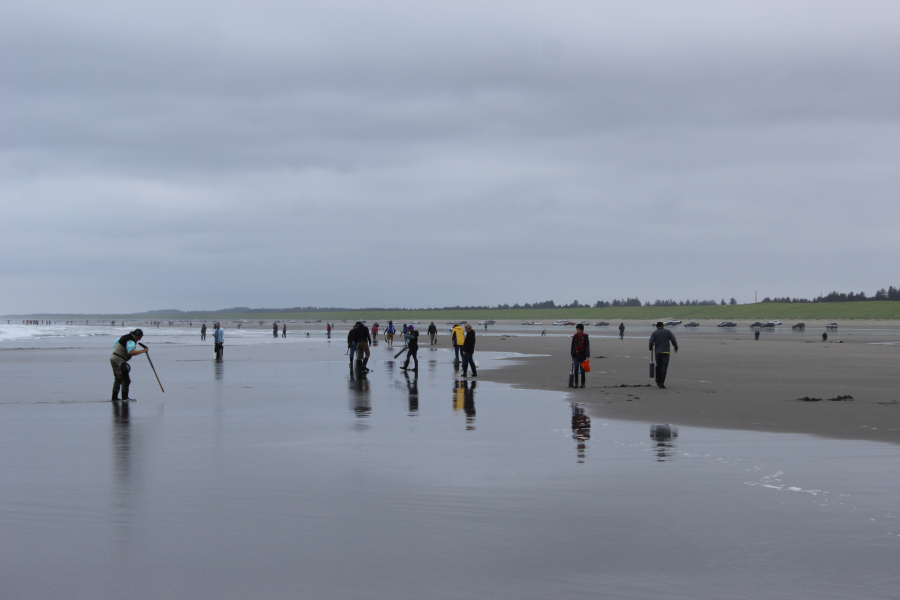I was on my knees digging swiftly and my nose was about one foot from the sand. I felt my fingers sweep over the tip of a clam, so I quickly grasped the clam firmly but lightly and drew it from the sand.
“Did you get him?” called a clammer from the edge of the beach. I showed him the clam and he flashed me a grin and a thumbs-up. “Alright!” he exclaimed.
I slipped the fat clam into my net and watched as the friendly fellow-clammer and his son worked along the water line. The youngster pulled a nice, big razor clam from the foamy sand.
Razor clamming is closed in Washington for the year, but it is still open in Oregon. I was clamming the Clatsop County beaches just across the Columbia River. Clamming is open in the Beaver State until July 15, and that allows clammers a chance to work the low tides of May and June.
Those are some of the lowest daytime tides of the year.
The Oregon clams are exceptionally large this year. Although it took a long time to find them, my take of 12 razors only included one dink.
According to Matt Hunter, the shellfish project manager for the Oregon Department of Fish and Wildlife, the clams being harvested this year are the progeny of a great pair of spawning years for razor clams.
“There was huge recruitment in 2014 and 2015,” said Hunter. “They were very exceptional year classes.”
He explained that razor clams are broadcast spawners, and some years the young survive in better numbers.
“The razor clam population is highly cyclic,” he adds.
If you have a penchant for razor clams you might want to get out during the June tides and get what you can. Next year may not be as fruitful.
Clammers are reminded they must keep the first 15 clams they dig, regardless of size or condition.
Razors do not often survive being dug up. “Any damage at all can be bad for them,” said Hunter. “There is an 80 percent mortality rate for damaged clams. It doesn’t take much to jeopardize their survival.”
The most successful clammers that day were pounding with a shovel near the water line to get the clams to show and then pouncing on them quickly.
A “show” is the dimple in the sand that indicates a clam’s position. Clammers use clam guns to suction up the razors or use a shovel and their hands to dig them up.
A shellfish license is required ($10 for resident, $28 for non-residents). Everyone must dig their own clams and keep them in a separate container.
The next sequence of minus tides will be from June 12 to 19. Always check the ODFW clam website for possible closures before clamming.
Rising tides, surfperch
My take of clams that morning had contained one that was pretty mangled by the clam gun, but I had plans for that clam.
As the tide turned and started to rise, many of the beach-goers stashed their clam gear and brought out the surfperch rods.
I joined them.
Choosing a spot that looked deeper than the average stretch, I rigged up. My 10-pound test mainline was tied to a three-way swivel. From the bottom loop I ran a 36-inch lead line dropper and tipped it with 5 inches of 3/8-inch pencil lead. On the remaining loop I slipped a pre-tied short leader and a No. 6 hook, tipped with clam meat.
I was using a 10-foot steelhead rod. It was stout enough to cast a long way, but light enough to enjoy the fight of the fish.
There are two tricks to catching surfperch. One, the surf has to be mild. Too rough and the fish won’t come in to shore. Second, you have to pick a depression along the beach.
In shallow areas the waves will curl and break. In deeper water the waves do not curl over, but gently roll to the shore. Even a depression of only 6 inches will draw surfperch.
Wading out as far as I could into the surf I made a long cast just beyond the breakers. I did not have to wait long for a bite. In the next hour I rarely made a cast that did not draw bites, and I managed to hook and land seven fat red fin surfperch.
Red fins are the tastiest of the surfperch species.
May and June are usually the best months for catching surfperch according to Mike Sinnott, the assistant district fish biologist for the Tillamook office of the ODFW.
“That’s when the big females come in to spawn,” said Sinnott.
It’s also a time of mild surf, bringing the fish closer to the beach.
Surfperch fishing is catching on.
“It’s getting more popular all the time,” said Sinnott. “They can be caught all year when the surf is low enough for them to come close to the shore.”
“I expect it to be really good through Mid-June. It should stay good until September when the surf picks up.”
A fishing license is all that is required to fish for surfperch in Oregon, (resident $41, non-resident, $103.50.)
One day and three day licenses are also available.





